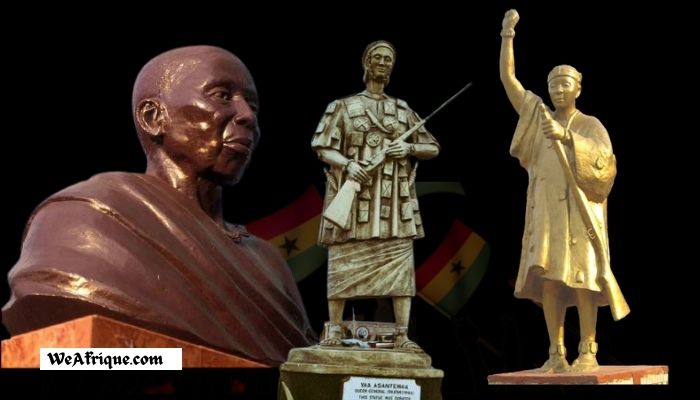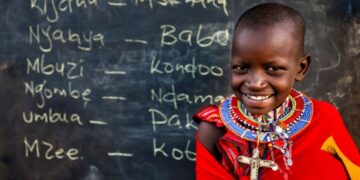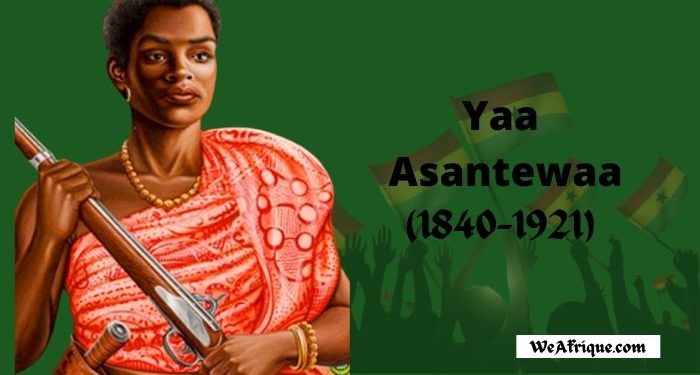- Yaa Asantewaa was a skilled farmer before she was appointed queen mother of the Ashanti Empire—now part of modern-day Ghana.
- She led about 5000 armies against the British invasion during the fifth Anglo-Ashante war which is mostly known as the Yaa Asantewaa war for the golden stool.
- The Ashanti Queen mother died in 1921 while in captivity on the Indian Ocean island of Seychelles but is greatly remembered as one of Africa’s warrior queens today.
Yaa Asantewaa, the Ashanti Queen Mother is one prominent figure in history modern-day Ghanaians can never forget. She was more than just a queen, she was a Pan-Africanist and anti-colonialist who was ready to lay down her life rather than give up the heart of her existence – the ancestral golden stool.
Yaa Ashantewaa in today’s generation is a paragon of hope, bravery, courage, and total patriotism. The Ashanti Queen Mother is largely celebrated in different ways as her legacy had inspired people for generations.
Additionally, several monuments, museum exhibitions, stage plays, and festivals have been used over the years to commemorate her defiant stance against the British.
A Brief Biography of the Ashanti Queen Mother
Yaa Asantewaa was born Nana Yaa Asantewaa to Kwaku Ampoma and Ata Po who were both farmers in Besease, Ghana. Asantewaa’s parents were from the ancient village of Ampabame in Kumasi. from which many of Ashante’s descent belonged. The actual year of her birth is not known but it is believed to be around the 1840s to 1860s while the date and month are October 17.
She was married to Owusu Kwabena the grandson of the seventh king of Asante who ruled from 1824 to 1834. Their union was blessed with a daughter named Nana Ama Sewaah.
Yaa Asantewaa was a skilled farmer before receiving the title of a queen mother in the 1880s. She was also the grandmother to Kofi Tene- the king of Elisa.
Read Also: African Tribal Women: 10 Things About Their Different Cultures
She Was Appointed the Queen Mother by Her Brother the King of Edwesu, Nana Akwasi Afrane
The kingdom of Ashanti which is modern-day Ghana was involved in five series of conflicts, two of which took place Before Yaa Asantewaa was born. At the end of the war in 1885, the people of Ashanti recorded several casualties including the chiefs of Ashantee. Yaa’s brother who was born as Asona royalty was made the king of Edwesu.
Kwasi Afrane appointed his sister as the Queen mother of Ejisu. Her appointment was as a result of the matrilineal culture of the Asante people and one of her most serious responsibilities was standing in as the main adviser of the king as well as the custodian of the Sikadwa, which is the Golden Stool of the Asante Kingdom and culture.
As a queen mother, Yaa was highly referenced among her people. She was well respected as a leader for her intelligence, wisdom, charisma, and sense of justice. She was the official protector of the empire’s ancestral stool.
She was the First Woman in the Ashanti History to Lead A War

In January 1896, the king of Ashante was captured and exiled by the British as his refusal to pay for the British expenditure was seen as an insult to Queen Victoria of England and the British Colonial government. The Asantehene was captured alongside the kings of Offinsu, some chiefs, his immediate family members, and Nana Yaa Asantewaa’s grandson Kofi Tene – King of Ejisu.
With this, the people of Asante were divided, the remaining Chiefs went into their tents while others joined forces with the British. Request to release the King of Asante was turned down and no man dared to challenge the authority of the British.
British Governor Sir Frederick Hodgson’s effort to bring the Ashanti nation under his control was fruitless. So he called for a meeting demanding the ancestral golden stool as he knew they will only pay allegiance to the stool bearer. The people of Asante were shocked by his demands as that was the heart of their existence but while some refuted, others conceded.
However, Yaa Asantewaa stood to her feet as the Ashanti queen mother and keeper of the stool. She reminded other chiefs of chiefs like Osei Tutu, Okomfo Anokye, and Opoku Ware I, who would not tolerate the insults of the white men. Men who would fire a shot to express anger. Asantewaa added that if they had lost hope in Ashanti as men, she would take up the mantle and lead women to war. The Queen mother was ready to lay down her life than surrender the golden stool.
Encouraged by her words, the remaining chiefs agreed to join Yaa for war. More than releasing their exiled kings and chiefs or securing the golden stool, they wanted true freedom. Yaa Asantewaa, the queen mother of Asante led a war with an army of over 5000 against the British in the fifth and final Anglo-Ashanti war mostly known as the yaa Ashanti war which lasted for several months.
The Ashanti Queen Mother, Yaa Asantewaa Died as a War-prisoner in Captivity
The fifth and final Anglo-Ashanti war referred to as the Yaa Ashanti war was the most brutal war compared to other Anglo-Ashanti wars. The people of Asante fought tirelessly until the British troops were outnumbered and outgunned and, fled the battleground. However, while they thought it was over, British Governor Sir Frederick Hodgson requested more fighters from Britain who actively responded with the release of about 1400 troops.
The people of Ashanti couldn’t resist the heat of the war anymore. They had lost most of their armies and were out of weapons. With this, Yaa Asantewaa was captured alongside other chiefs and commanders and kept as prisoners on the Indian Ocean island of Seychelles.
In 1921, the Ashanti Queen died in her sleep as a prisoner in Seychelles. Howbeit, the golden stool was retained and kings and chiefs who were exiled returned to the Ashanti Empire. Also, King Prempeh I traveled to Kumasi and requested the remains of Asantewaa and other Ashanti people who died in exile for a royal burial.
Note-worthy Legacies of Yaa Asantewaa
The bravery and resistance of the Ashanti queen mother have earned her a place of honor in modern-day Ghana. Here are some worthy to note accomplishments of the Yaa Asantewaa:
1. The Asante Territory Gained Independence as Part of Ghana
Though Yaa Asantewaa ended up in exile and didn’t live to witness the freedom she fought for, she is greatly remembered as a strong-willed woman whose bravery brought about freedom from the colonial ruling.
The Ashanti region became the first African nation in Sub-Sahara Africa to gain independence on March 6, 1957. Also, Yaa Asantewaa was depicted on the Ghanaian twenty cedi currency from 1984-1986.
2. A Museum in the District of Ghana Was Dedicated to Yaa Asantewaa
In 2000, a week-long celebration was held to acknowledge her achievements. Following after, a museum was dedicated to her as part of the celebration on August 3, 2000. Historical items like her sandals and battle dress (batakarikese) and other ancient weapons were kept there but the fire outbreak on July 23 2004 destroyed most of them.
Also, women who uphold great values are honored with the achievement award titled “Nana Yaa Asantewaa Awards” (NYA).
3. The Yaa Asantewaa Girls Senior High School Was Established
The Yaa Asantewaa school in the Atwima Mpona District in Kumasi in the Ashanti Region Of Ghana was established in 1951 by the first President of Ghana Dr. Kwame Nkrumah. The college was named after Yaa Asantewaa the Queen mother of Ejisu who opposed the British colonist in the 1900s.
More than producing women of intellect, the Yaa Asantewaa school focuses on producing women of value and encouraging more female leaders to actively thrive for greatness. A Yaa Asantewaa Statue was erected in 2009 by the Canadian non-profit organization Yensomu Youth and the community.
4. Presentations reflecting on Yaa Asantewaa
Ivor Agyeman released two TV documentaries in 2001 to galvanize Ghanaians on the birth of their freedom. It was titled “Yaa Asantewaa – The Exile of King Prempeh and the Heroism of An African Queen”.
Moreso, a stage show written by Margeret Busby and directed by Geraldine Connor titled ‘Yaa Asantewaa: Warrior Queen” was displayed across the United Kingdom and Ghana from 2001 to 2000. All cast in the show were Africans including the renowned drummer Kofi Ghanaba.





















Discussion about this post